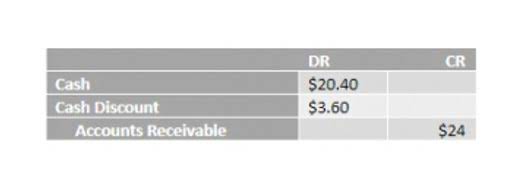
Sales returns, allowances, and discounts are the three main costs that can affect net sales. All three costs generally must be expensed after a company books revenue. As such, each of these types of costs will need to be accounted for across a company’s financial reporting in order to ensure proper performance analysis. If you’re a supplier, talk to your accountant or business manager about what invoice payment terms are best for your cash flow. And if you’re a customer, don’t be afraid to talk to your supplier about cash discounts or extending payment terms. Before it comes time to get paid, you’ll first have to create an invoice, and perhaps the most important element of an invoice is the payment terms.
- If a cash discount is offered, that’ll usually be printed on the invoice, too.
- The payment must be made in full by the allotted time, otherwise the bill is overdue and the vendor can invoice for late fees.
- Whether you want to pay off debt, create a manageable budget or save for a home, understanding net income could be the first step in managing your money.
- According to Bankrate, COGS includes the amount of money a company spends on making or acquiring goods for resale.
- Other common net invoice terms include net 7, net 10, net 30, net 60, and net 90.
- Gross pay is an employee’s total earned wages before payroll deductions.
They can often be factored into the reporting of top line revenues reported on the income statement. For example, a business may indicate they’d like to be paid immediately, net 30, net 60, or even net 90. And the seller https://www.bookstime.com/ or service provided may also indicate whether they’d like payment via cash, check, credit card, wire transfer, or some other method. If a cash discount is offered, that’ll usually be printed on the invoice, too.
How to choose the right payment terms for your business
For businesses, net income can usually be found on the bottom line of a company’s income statement. You can calculate gross pay for salaried employees by dividing the annual salary by the number of pay periods. For example, let’s say an employee makes $60,000 per year and gets paid monthly. Simply divide $60,000 by 12 to figure out the gross pay ($5,000 per paycheck). Net pay is calculated by subtracting all of the deductions from your gross pay.
One other thing to know when figuring out net income for a business is the cost of goods sold (COGS). According to Bankrate, COGS includes the amount of money a company spends on making or acquiring goods for resale. Companies often use an income statement, which typically shows all income and expenses. Knowing your net income, or net pay, can be a good way to budget and look for areas where you could cut back on spending. And for businesses, it can also offer a picture of how much profit a company is bringing in. Not only are gross and net pay records required by law, but they can also save your business from costly lawsuits and penalties that affect company profits, reputation, and more.
Net 15 Payment Terms: What They Mean for Your Business Cash Flow
Instances of businesses successfully incorporating Net 14 payment terms and reaping their benefits are not hard to come by. For instance, several retail industry giants have used these terms effectively to maintain their robust cash flow whilst fostering strong relationships with their suppliers. There are many reasons why net income is important, such as determining what does net 14 mean how much profit can be divided among investors and how much money can go toward new projects. With the net income formula, you can easily calculate how profitable your business is by finding the difference between your total revenue and total expenses. Many companies working on an invoicing basis will offer their buyers discounts if they pay their bills early.

